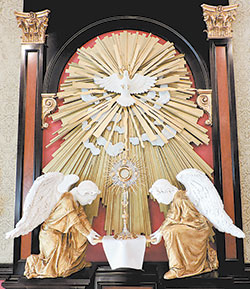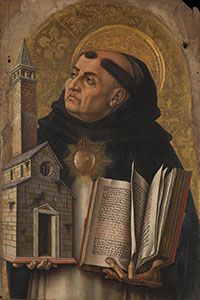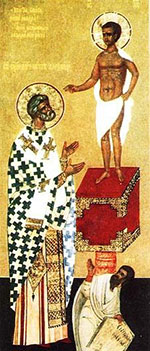 Eucharistic Adoration is the adoration of Jesus Christ present in the Holy Eucharist. In the many churches that have this adoration, the Eucharist is displayed in a special holder called a monstrance, and people come to pray and worship Jesus continually throughout the day and often the night.
Eucharistic Adoration is the adoration of Jesus Christ present in the Holy Eucharist. In the many churches that have this adoration, the Eucharist is displayed in a special holder called a monstrance, and people come to pray and worship Jesus continually throughout the day and often the night.
Christ’s great love for us was shown when He was crucified on the cross to pay the penalty for our sins and give us eternal life. He loves us without limit, and offers Himself to us in the Holy Sacrament of the Eucharist.
The worship and custody of the Holy Eucharist, independently of Mass and Holy Communion, can be traced to post-apostolic times. St. Justin, writing in his Apology around the year 150, says that deacons were appointed to carry the Blessed Sacrament to those who were absent from the liturgy. The young St. Tarsisius was taken captive and put to death while carrying the consecrated Species on his person. St. Eudocia, martyred under Trajan, was first permitted to visit her oratory and remove a particle of the Host which she took with her to prison. What appears to be the first explicit reference to a tabernacle occurs in the Apostolic Constitutions, compiled towards the end of the fourth century, which provided that “deacons should take the remaining particles of the Sacred Species and place them in the tabernacle.”
Implicit in these and similar provisions was the Church’s constant belief in the Real Eucharistic Presence of Christ in the Blessed Sacrament. Thus, in the words of St. Augustine, “No one eats that flesh without first adoring it” (“Expositions on the Psalms,” 98:9). It was on this doctrinal basis that the cult of adoring the Eucharist was founded and gradually developed as something distinct from the Sacrifice of the Mass. At the Council of Trent, Protestants were condemned for denying that the Eucharist is at once a sacrifice and a sacrament; that it differs from other sacraments in not only producing grace “ex opere operato Christi” (deriving their power from Christ’s work), but containing in a permanent manner the Author of grace Himself.
In his 1965 encyclical “Mysterium Fidei,” Pope Paul VI wrote, “The Catholic Church has always devoutly guarded as a most precious treasure the mystery of faith, that is the ineffable gift of the Eucharist which she received from Christ her Spouse as a pledge of His immense love, and during the Second Vatican Council in a new and solemn demonstration she professed her faith and veneration for this mystery...
“No one can fail to understand that the Divine Eucharist bestows upon the Christian people an incomparable dignity. Not only while the sacrifice is offered and the sacrament is received, but as long as the Eucharist is kept in our churches and oratories, Christ is truly the Emmanuel, that is, ‘God with us.’ Day and night He is in our midst, He dwells with us, full of grace and truth. He restores morality, nourishes, virtues, consoles the afflicted, strengthens the weak. He proposes His own example to those who come to Him that all may learn to be, like Himself, meek and humble of heart and to seek not their own interests but those of God.”
Adoration means coming before the Real Presence of the Lord in the Eucharist. But what does that mean? What, or better who, is the reality of which we speak when we talk about the Real Presence?
This reality, as the Church has solemnly defined the truth for the faithful, is the “totus Christus,” the whole Christ: body and blood, soul and divinity. This is not a rhetorical expression nor a verse of poetry. It is an article of the undivided Roman Catholic faith.
There can be no doubt what the faithful are told when they are told to believe in this mystery. Once the words of consecration have been pronounced by a validly ordained priest, what used to be bread and wine are no longer bread and wine. Only the appearances or, rather, only the external physical properties of the former elements, remain. There is now on the altar Jesus Christ, true God and true man, full God and full man.
Does this mean that Jesus is present in the Eucharist? Yes. Is it Jesus in His divine nature? Yes. Is it Jesus in His human nature? Yes. But if Jesus in the Eucharist is really and truly present, is He there with all that makes Him not only man, but makes Him this man? Yes. After all, when God assumed human nature, He assumed this nature as a particular single human being. The divine Person of the Son of God did not merely in some abstract sense become human. He became a definite, historically specific human being.
Thus in the Eucharist is present the Jesus of history: the one who was conceived of His mother Mary at Nazareth; who was born in a stable at Bethlehem; who lived for 30 years in Palestine; and who walked and talked and wept and slept and ate and drank; who shed real red blood on the cross and who rose from the grave, and after His resurrection had the incredulous disciples put their fingers into His pierced side.
When, then, we speak of the Real Presence we imply that part of this reality, which is Christ, is the heart of flesh and blood that every human being has and also Christ has in the glorified body He now possesses since the resurrection.
Note what we are saying. We are affirming that the Sacred Heart of Jesus is not only a historical memory, as recorded by St. John when he tells us that the sacred side of the Savior was pierced on Calvary. Nor are we saying merely that, rising from the dead, Christ is now at the right hand of His heavenly Father in body and soul and therefore also with His human heart. Nor are we saying simply that in the Eucharist is some sort of abstract memorial of the real Christ, who is actually in heaven and no longer on earth. No; we profess on faith that Jesus is now simultaneously both in heaven and on earth; that He truly ascended into heaven and is truly still on earth; that although He left us visibly He is with us really.
This means that the heart of Christ is in our midst, because Jesus is in our midst. He is the same Jesus in heaven and on earth. So He must be present here with His Sacred Heart of flesh, living and beating in the bosom of a living human being.
He is present with His Sacred Heart, at once human and divine: human because He has a genuine human nature, like ours in all things but sin, and a truly divine nature, like that of the Father, with whom He is one God, in the unity of the Holy Spirit.
But that is not all. We know that the heart of Christ is more than just a physical organ of His human body. It is also the symbol of God’s love for the human race, and, indeed, of the eternal love (that obtains) within the Blessed Trinity.
The important aspect of this is the fact that we have in the Holy Eucharist not only the physical Christ in His human and divine natures and therefore His heart of flesh substantially united to the Word of God. We have in the Eucharist the effective means by which we can show our love for God, since it is not just our own affections when we unite them with the heart of the Eucharistic Christ. It is His affections joined with ours. His love elevates ours, and ours as a consequence is raised to a participation in the divinity.
But more than that. By our use of the Eucharist, that is, by our celebrating the Eucharistic Liturgy and by our reception of the heart of Christ in Holy Communion, we receive an increase of the supernatural virtue of charity. We are thus empowered to love God more than we would ever be able to do otherwise, especially by loving the people whom He graciously – though often painfully – places into our lives.
Whatever else the heart symbolizes, it is the world’s most expressive sign of outgoing charity.
It is precisely here that the Holy Eucharist supplies what we could never do by ourselves: loving others with total self-sacrifice. We must be animated by the light and strength that comes from the heart of Jesus Christ. If, as He said, “without me you can do nothing,” it is certainly impossible to give ourselves to others, tirelessly and patiently and continually, in a word, heartily, unless His grace gives us the power to do so.
And where does His grace come from? From the depths of His divine heart, present in the Eucharist, offered daily for us on the altar and available to us always in the sacrament of Holy Communion.
— Jesuit Father John A. Hardon
At www.therealpresence.org: Read about the history and miracles associated with Eucharistic Adoration, get resources for introducing
children to Adoration, find lots of tips on how to pray a Holy Hour, and learn more about practices such as the Forty Hours Devotion and the First Friday Devotion
Spend time with Our Lord
The Diocese of Charlotte is blessed to have Perpetual Adoration of the Blessed Sacrament offered in five locations. All of the faithful, of any age, are invited to participate! Stop by anytime or sign up for a regular Holy Hour:
BELMONT
Belmont Abbey College’s St. Joseph Perpetual Adoration Chapel, 100 Belmont-Mt. Holly Road
Margaret Fox 704-648-8947
Details: www.belmontabbeycollege.edu/about/community
CHARLOTTE
St. Gabriel Church, 3016 Providence Road
Estelle Wisneski 704-364-9568
HICKORY
St. Aloysius Church’s Immaculate Heart of Mary Perpetual Adoration Chapel, 921 2nd St. N.E.
Karen Sadlowski 828-308-5454
Details: www.staloysiushickory.org/perpetual-adoration
HIGH POINT
Pennybyrn at Maryfield Perpetual Eucharistic Adoration Chapel, 1315 Greensboro Road
Edna Corrigan 336-324-4366
Details: www.maryfieldeucharistic.org
HUNTERSVILLE
St. Mark Church’s Monsignor Bellow Perpetual Adoration Chapel (located in the Monsignor Joseph A. Kerin Family Center), 14740 Stumptown Road
Mary Sink 704-892-5107 or email This email address is being protected from spambots. You need JavaScript enabled to view it.
Details: www.stmarknc.org/adoration
The start of school is nearly here, and for students, parents and teachers, it’s the perfect opportunity to reflect and pray that the coming months will be fruitful and fun for everyone. The saints are always there to help us on our journey, so here are three saints for you to consider as the 2024-’25 school year dawns:
St. Catherine of Alexandria (c. 287-305)
Feast day: Nov. 25 Catherine is thought to have been born to a noble family in Alexandria, Egypt. Through a vision, this scholarly young woman converted to Christianity and began evangelizing others, including the wife of the pagan emperor who was persecuting Christians. According to legend, after she defied the emperor and refuted philosophers brought in to test her faith, she was imprisoned and tortured.
Catherine is thought to have been born to a noble family in Alexandria, Egypt. Through a vision, this scholarly young woman converted to Christianity and began evangelizing others, including the wife of the pagan emperor who was persecuting Christians. According to legend, after she defied the emperor and refuted philosophers brought in to test her faith, she was imprisoned and tortured.
She was put on a rotating spiked wheel; when it broke, she was beheaded. She is venerated as the Great Martyr St. Catherine in the Orthodox tradition and her voice was among those heard by St. Joan of Arc. Today, she is known as the namesake of a monastery at Mount Sinai that claims to be the oldest in the world. She is the patron saint of wheelwrights, and also a patron saint of teachers, jurists, philosophers, students and teachers.
St. Thomas Aquinas (1225-1274)
Feast day: Jan. 28
 Thomas so shocked his noble Italian family when he entered the Dominicans about 1244 that his brothers kidnapped him from the Dominicans, took him to the family’s castle, and at one point even sent a woman to seduce him – whom Thomas drove out by brandishing a poker from the fireplace. But he would not yield, and studied under St. Albert the Great, becoming a master of theology in 1256. As a priest, he showed great reverence for the liturgy and skill as a homilist.
Thomas so shocked his noble Italian family when he entered the Dominicans about 1244 that his brothers kidnapped him from the Dominicans, took him to the family’s castle, and at one point even sent a woman to seduce him – whom Thomas drove out by brandishing a poker from the fireplace. But he would not yield, and studied under St. Albert the Great, becoming a master of theology in 1256. As a priest, he showed great reverence for the liturgy and skill as a homilist.
In keeping with the Dominican order’s charism for preaching, he strove to bring his own family to a sincere practice of the faith, and largely succeeded. For the rest of his brief life, the “dumb ox,” as he was dubbed, taught, preached and wrote, producing the monumental “Summa Theologica.” The 13th century theologian showed that the Catholic faith is in harmony with philosophy and all other branches of knowledge. His thinking became enormously influential in later centuries and he was named a Doctor of the Church in 1567. In 1965, the Second Vatican Council taught that seminarians should learn “under the guidance of St. Thomas,” in order to “illumine the mysteries of salvation as completely as possible.” He is also a patron saint of academics, chastity, colleges and universities, Catholic schools and theologians.
St. Peter of Alexandria (died 311)
Feast day: Nov. 26
 Born in Alexandria, Egypt, Peter headed its catechetical school before being named bishop-patriarch in 300. In his early Church history, Eusebius called Peter an excellent teacher. Peter’s own theological writings were cited in a fifth-century dispute over Christ’s divinity and humanity. Peter fought two heresies, Arianism and Origenism, and for much of his episcopate encouraged his people to remain Christian in the face of Emperor Diocletian’s persecutions.
Born in Alexandria, Egypt, Peter headed its catechetical school before being named bishop-patriarch in 300. In his early Church history, Eusebius called Peter an excellent teacher. Peter’s own theological writings were cited in a fifth-century dispute over Christ’s divinity and humanity. Peter fought two heresies, Arianism and Origenism, and for much of his episcopate encouraged his people to remain Christian in the face of Emperor Diocletian’s persecutions.
When he eventually went into hiding, Alexandria experienced a schism, and when a new emperor renewed Christian persecutions, Peter was seized and summarily executed. He was the last Christian martyred in Alexandria by civil authorities. His instructions on how to receive “lapsed” Christians who had denied their faith back into the Church were adopted by the entire Eastern Church. Although his feast day in the Western tradition is no longer a part of the Roman Catholic Church’s universal calendar, he remains especially beloved among Catholic and Orthodox Christians of the Egyptian Coptic tradition. He is also a patron saint of Egypt.
— Catholic News Service and Catholic News Agency

